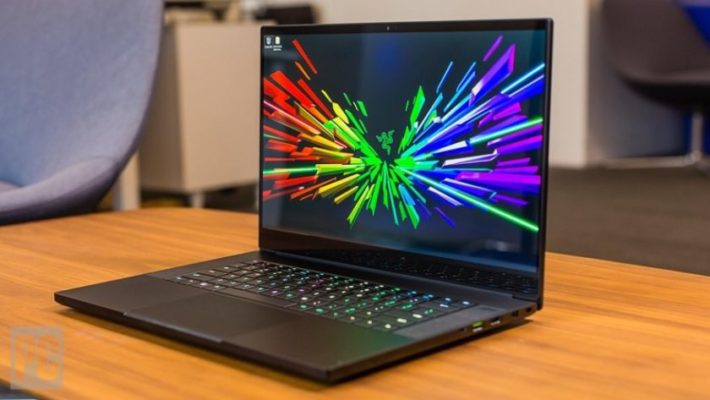Why should you buy Razer Blade 15 Advanced 2020? Razer’s new Blade 15 gaming laptop is a refresh both inside and out, with powerful new specs from Intel and Nvidia, as well as a few small and long-awaited adjustments to the chassis design. Reveal more in Razer Blade 15 Advanced 2020 review.
Razer Blade 15 Advanced 2020 comes in 2 models – the base model for $1,600 and the upgraded “advanced” model, the latter of which will host Intel’s 10th Gen i7-10875H eight-core CPU (base speed of 2.3GHz, turbo speed of 5.1GHz). On the graphics end, it comes with the Nvidia GeForce RTX 2070 Super Max-Q graphics chip to start, and you can upgrade further to the RTX 2080 Super Max-Q. The advanced model is clearly meant to be the showcase for next-gen mobile computing performance. We cover all in our Razer Blade 15 Advanced 2020 review.
The lesser model is no slouch, though. It houses a six-core 10th Gen Intel i7-10750H processor (base clock speed of 2.6GHz and turbo boost clock speed of 5GHz), starts with Nvidia’s GeForce GTX 1660 Ti graphics, and is configurable up to Nvidia’s RTX 2070 Max-Q graphics chip (the new Super lineup is exclusive to the advanced model). If you don’t want to shell out for high-end mobile graphics, you could always consider Razer’s external GPU enclosure into which you can fit a desktop-class GPU.
Razer Blade 15 Advanced 2020 price and availability
Two main variants of the Razer Blade exist: the Advanced Model and the Base Model. Both are powerful and can run the latest games with ease but the Advanced model has some extra features and that bit more juice.
Base variant comes with the 144Hz Full HD non-touch screen. Inside it has a 2.6GHz six-core Intel Core i7-10750H CPU and 16GB of system RAM running affairs, a single 512GB NVMe SSD and an Nvidia GeForce RTX 2070 GPU with 8GB of GDDR6 RAM. The list price for this model is £2,100 but you can save a fair bit by opting for the less-capable GeForce GTX 1660 Ti. This drops the price to around £1,700.
Go the other way, replace the Full HD display with the 4K DCI-P3 OLED (non-touch) screen and the price rises to £2,400, while upping the GPU and CPU increases it even higher. The top-spec Advanced model with the 4K OLED touchscreen, Intel Core i7-10875H CPU and RTX 2080 Super GPU will set you back an eye-watering £3,350.
The latest Dell XPS 15 is slimmer and lighter than the Blade and more expensive for the closest equivalent specification. Again, this isn’t a gaming machine, and doesn’t come with the option of a high refresh rate display either.
The closest competitor is Gigabyte Aorus 15G XB, which comes with a Core i7-10875H, 16GB of RAM, an Nvidia RTX 2070 Super and 512GB of storage for £2,199 (with the regular RTX 2070 it’s £1,999). This is most definitely a gaming machine, comes complete with a mechanical keyboard, and is a better all-round performer than the Blade but it isn’t as attractive and is comparatively chunky, too.
Those are big numbers, to be sure, but how do these compare with rivals? First up, the Apple MacBook Pro 16in, which starts at £2,399 for a configuration that includes the six-core 2.6GHz ninth-gen Intel Core i7-9750H, 16GB of RAM, an AMD Radeon Pro 5300M and 512GB of storage. That’s £300 more for a laptop with a less powerful GPU but a larger, higher-resolution display, a bigger battery and a slimmer chassis. That isn’t really a gaming laptop, though, and its AMD GPU is no match for the RTX 2070 in the equivalent Blade 15.
Razer Blade 15 Advanced 2020 specs
- Screen Size 15.6 inches
- Max Screen Resolution 1920 x 1080 pixels
- Memory Speed 2933 MHz
- Graphics Coprocessor NVIDIA GeForce RTX 2080 Super
- Chipset Brand NVIDIA
- Card Description Dedicated
- Graphics Card Ram Size 8 GB
- Wireless Type Bluetooth, 802_11_ABGNAC
- Number of USB 3.0 Ports 3
- Other Technical Details
- Brand Name Razer
- Series Blade 15
- Hardware Platform PC
- Operating System Windows 10
- Item Weight 9.02 pounds
- Product Dimensions 13.98 x 0.7 x 9.25 inches
- Item Dimensions L x W x H 13.98 x 0.7 x 9.25 inches
- Processor Brand Intel
- Processor Count 8
- Computer Memory Type Ddr4_sdram
- Flash Memory Size 16
- Optical Drive Type No Optical Drive
- Batteries 1 Lithium ion batteries required. (included)
Compare Razer Blade 15 Advanced vs Razer Blade Pro 17 Gaming Laptop
| Razer Blade 15 Gaming Laptop 2020 | MSI GS66 Stealth Ultra Thin and Light Gaming Laptop | Razer Blade Pro 17 Gaming Laptop 2020: | |
|---|---|---|---|
| Computer Memory Size | 16 GB | 16 GB | 16 GB |
| CPU Model Manufacturer | Intel | Intel | Intel |
| CPU Speed | 5.1 GHz | 2.6 GHz | 5.1 GHz |
| Display Resolution Maximum | 1920 x 1080 pixels | 1920 x 1080 pixels | 1920 x 1080 pixels |
| Screen Size | 15.6 inches | 15.6 inches | 17.3 inches |
| Item Dimensions | 13.98 x 0.70 x 9.25 inches | 14.17 x 9.65 x 0.71 inches | 15.55 x 10.23 x 0.78 inches |
| Item Weight | 9.04 lbs | 4.63 lbs | 10.14 lbs |
| Operating System | Windows 10 | Windows 10 Pro | Windows 10 |
| Processor Count | 8 | 6 | 8 |
| RAM Type | DDR4 SDRAM | DDR4 SDRAM | DDR4 SDRAM |
| Wireless Communication Standard | Bluetooth, 802.11a/b/g/n/ac | 802.11ax | 802.11a/b/g/n/ac |
Razer Blade 15 Advanced 2020 review
What are key changes?
The new Blade 15 comes with a 15.6in IPS display that can be specced with a high refresh rate of 144Hz or 300Hz in Full HD resolution; or as a 4K, wide-gamut OLED non-touch or touchscreen.
The laptop sits in the middle of Razer’s range of gaming laptops, below the Razer Blade Pro 17 (2020) and above the Razer Blade Stealth, which is an ultraportable, intended more for occasional gaming. Effectively, the 15 is the best-value proper gaming machine Razer offers, then, designed to game all day without skipping a beat.
As noted already, aside from a few subtle changes, which I’ll go into below, nothing much has changed on the design front this year. All the main changes have been made to the specifications.
As for GPU choices, you can go with the Nvidia GeForce GTX 1660 Ti, RTX 2070, RTX 2070 Super, RTX 2080, or the RTX 2080 Super, with prices rising commensurately as you go up the range. There’s plenty of choice, in other words, to suit a range of budgets.
Inside, you have a choice of the new six-core 2.6GHz Core i7-10750H or the new eight-core 2.3GHz Core i7-10875H processors, with 16GB of system RAM and either a 256GB or a 512GB NVMe SSD.
Design – Razer Blade 15 Advanced 2020 review
One thing you definitively say about the new Razer Blade 15 (because the same held true of the old machine) is that it’s the most attractive gaming laptop you can buy. Although some rivals offer slightly slimmer, lighter cases, there isn’t a huge amount in it. The Blade weighs a mere 2.1kg and measures 19.9mm thick, which isn’t much more than the equally gorgeous (and more expensive) 16in MacBook Pro.
There are some differences between this model and the older 2019 Blade machine, which are worth taking note of, however, and some key differences between the Base model and the Advanced models, which aren’t immediately apparent.
There are also changes inside the machine, which can be opened up fairly easily by unscrewing ten tiny Torx T5 screws set around the edges of the bottom panel. Here, the Blade 2020 drops the 2.5in SSD bay from last year’s model, replacing it with a single empty full-length M.2 slot, while the Advanced model loses the free slot entirely. On the flipside, the Blade 15 (2020) Advanced has a better vapor-chamber cooling system than the Base model and a slightly larger battery.
Elsewhere, it’s pretty standard stuff. Wireless connectivity is catered for by a 2×2 MIMO Intel AX201 WiFi6 adapter and Bluetooth 5. The webcam is a fairly uninspiring 720p jobbie that struggles with extremes of light and dark. The microphone is fairly good, however, and the speakers go pretty loud but aren’t particularly rich or full-bodied. Compared with the MacBook Pro’s webcam and audio setup, particularly the superlative studio microphone, the Razer lags a long way behind. There’s also no form of biometric login available on any Razer Blade 15, which feels a little backward.
Display
The 144Hz 1080p display in the Base model is a pretty good one but it won’t blow you away with its image quality. It’s perfectly sharp at normal viewing distances and goes reasonably bright, too, up to a point.
A maximum of 377cd/m² is fine for indoor use and it’ll be viewable outdoors in a shady spot if you fancy doing a bit of work or gaming on your patio. Colour representation is absolutely fine with an sRGB gamut coverage of 87.1% (out of a total of 90.3% by volume), and there are no serious problems with colour accuracy in sRGB either, with the average Delta E hitting 1.94 (the lower the better).
It’s no MacBook Pro 16in display but neither does it offend in any particular way. And although it’s a touch less vibrant, it’s a lot brighter than the Gigabyte Aorus 15G’s 240Hz screen.
Refresh rate – Razer Blade 15 Advanced 2020 review
One is a matte 1080p panel that seems modest at first blush, but with its super-fast 240Hz refresh rate, it’s the option most gamers will want. Most people game at 1080p, and you can enjoy framerates up to 240 FPS without stuttering or skipped frames.
You might scoff at the idea of needing a refresh rate that high. There are few games that can push framerates above two hundred. However, they’re the games that matter most. Counter-Strike: Global Offensive, for example, is an esports title where competitive players desire every possible edge they can get on their opponents. That’s where the 240Hz screen comes into play.
Ports & connectivity
First up, connectivity. The Base model gets an extra USB-C port this year, bringing the total to two. The one on the right is a Thunderbolt 3 port and the one on the left is a USB 3.2 Gen 2 port (max 10Gbits/sec). On the Base model, neither can be used to charge the machine, which is a bummer if you’ve got it connected to your monitor via USB-C all day. That’s a feature (rather unnecessarily in my view) reserved for the Advanced model.
These USB ports are supplemented by three further USB A ports, all USB 3.2 Gen 1 (max 5Gbits/sec) – two on the right, one on the left – and a Gigabit Ethernet socket, which you don’t get on the Advanced model. I know, confusing, isn’t it? The 2020 Blade also loses the Mini DisplayPort this year but retains a full-sized HDMI output on the right edge.
Keyboard and touchpad
The Razer Blade has an outstanding keyboard and touchpad. The touchpad is one of the largest you’ll find, nearly matching the size of the 15-inch MacBook Pro. The extra space looks great and offers plenty of room for things like two-finger pinches or four-finger swipes. The tracking is precise, the texture is smooth, and thanks to Windows Precision drivers, gestures work perfectly. All of that is a rare on a gaming laptop, even in this price range.
The typing experience is impressive, too. Though not as tactile as the mechanical keyboard featured on the Alienware Area-51m or older Razer Blade Pro, the Blade’s keyboard feels responsive and precise.
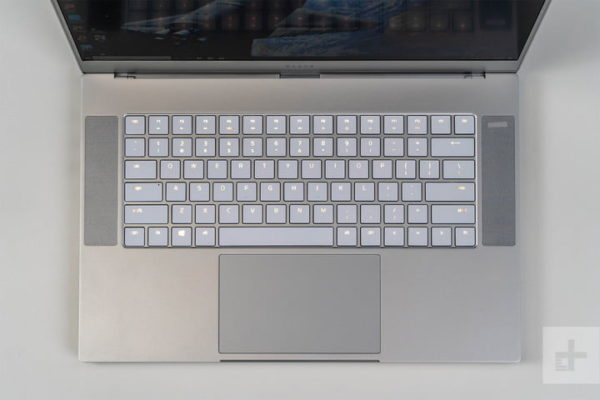
Razer’s ever-present Chroma RGB lighting has improved this year. It’s as bright and customizable as ever. It’s all easily edited through Razer Synapse, and even comes with an unprecedented fourteen levels of brightness. Now that is meticulous control. On the 2018 Blade, the small symbol under each Function key wouldn’t light up when the function key was held down. Now it does. It was a small annoyance if you were in the dark and didn’t have the exact location of the volume button memorized. Though a subtle change, I like that Razer responded to the feedback.
I do have a couple of hang-ups, though. The layout is an issue. I complain about this with every Razer laptop, but the full-sized arrow keys create a stumbling block for fast typing. The space between the Shift key and the question mark key creates a learning curve. It’s more forgivable here than on the Razer Blade Stealth, since the standard Blade can actually handle games. After a few days of use, I became familiar, but anytime I switched over to a different keyboard, it was another adjustment I had to make.
An infrared Windows Hello camera is a new addition in 2019, placed next to the 720p webcam above the display. It’s a small touch, but proves Razer is serious about making the Blade competitive.
Storage and gaming options
All configurations of the Razer Blade come with the same, fast storage option, a Samsung PM981 M.2 SSD. This ranks among the fastest SSDs we’ve tested in a gaming laptop. The Blade averaged well over 1500 MB/s in read and write speeds in CrystalDisk Mark. File transfers were quick and tasks like opening apps happen at a snap.
You won’t find a faster SSD in a gaming laptop, but even if you want to upgrade it to something with more capacity, storage is accessible via the single removable panel. I do, however, wish there were larger storage configurations available. 512GB is enough to install several games, but some gaming laptops now offer up to 2TB in top configurations.
Audio
I’m really impressed with the dual top-firing speakers on the Blade 15’s deck.
In Hitman 2, I could hear race cars humming around a track as I hid in a filthy, fly-infested dumpster waiting for my pursuers to give up their search. The speakers were clear enough that I could hear the charter of bystanders through the ringing gunshots fired toward me after I mistimed my escape.
The speakers did a good job of capturing the airy, dream-like quality of Brandon Flower’s “Between Me and You.” Piano chords were crisp and Flowers’ voice was front-and-center. The speakers did a good job filing a medium-size room, but bass thuds in Glass Animals’ “Pork Soda” were weak.
Gaming, graphics and VR
Packing an Nvidia GeForce GTX 1660 Ti GPU with 6GB of VRAM, the Blade 15 can play most modern games on high settings without dropping below our 30 frames per second threshold. I fired up Hitman 2 and enjoyed between 65 fps and 80 fps as I snuck around police officers and eliminated targets.
The Razer Blade 15 consistently outperformed rival laptops equipped with the same graphics card on our benchmark tests. The Blade 15 ran Rise of the Tomb Raider (1080p on Very High) at 46 fps, which tops the Omen 15 (44 fps, GTX 1660 Ti) and the Asus ROG Zephyrus G GA502 (43 fps, GTX 1660 Ti) but not the mainstream gaming average (48 fps).
We saw similar results on the Hitman test in which the Blade 15 notched 80 fps, whereas the Omen 15 (78 fps) and ROG Zephyrus G GA502 (73 fps) didn’t come close to that mark. Again, the gaming average (84 fps) edged out those laptops.
The Blade 15 also did a good job on the Grand Theft Auto V benchmark, powering the popular game at a steady 64 fps. Again, the competition failed to match the Razer, although the Omen 15 (60 fps), ROG Zephyrus G GA502 (57 fps) and the gaming average (59 fps) put in decent results.
Metro: Last Light is a demanding game, but the Razer Blade 15 Base Model played the post-apocalyptic first-person shooter at 55 fps, beating the Omen 15 (40 fps) and the category average (40 fps).
Battery Life
With a runtime of 5 hours and 48 minutes on our battery test (continuous web surfing over Wi-Fi at 150 nits), the Razer Blade 15 Base Model has great endurance for a gaming laptop. Competing laptops with GTX 1660 Ti graphics, like the Omen 15 (3:05) or the ROG Zephyrus G GA502 (4:48), will power down long before the Blade 15. Razer’s laptop even tops the mainstream gaming category average (4:01) by more than an hour.
Razer Blade 15 Advanced 2020 performance review
And now to the meat of the matter. How does the Razer Blade 15 (2020) perform? With the very latest 10th gen Comet Lake Intel chips inside and Nvidia’s RTX graphics, the answer is, unsurprisingly, pretty darned well.
I’ve run the machine through a variety of benchmarks, from our own media-focused transcoding, image conversion and multitasking tests, through cross-platform CPU and graphics tests, to a range of real-world gaming benchmarks, and the Blade performed brilliantly across the board – although not any faster or slower than expected given the specification.
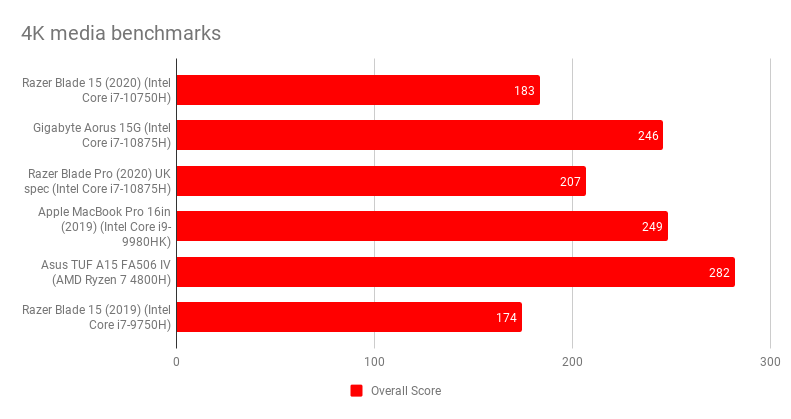
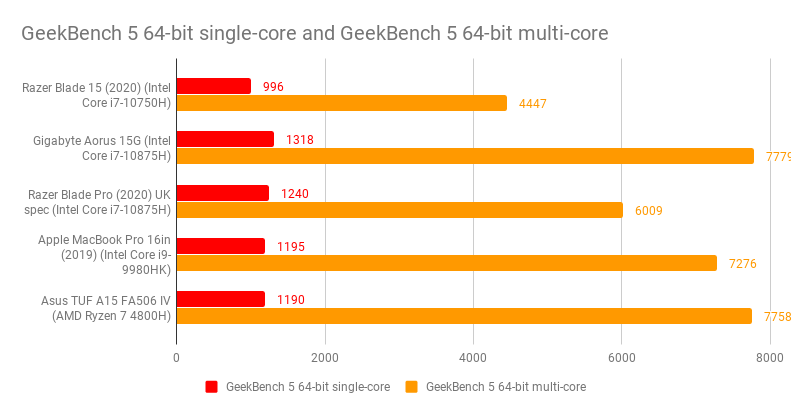
So, it’s a faster machine than last year’s model at CPU-bound tasks (it has a faster CPU) but a little slower at gaming and graphics-heavy tasks. That’s because the Razer Blade 15 we tested last year had an Nvidia RTX 2080 inside where this one has the slightly less capable RTX 2070.
That also makes this year’s Razer Blade 15 the slowest of the 10th-gen gaming laptops we’ve tested this year, by dint of having the lowest spec GPU. The Gigabyte Aorus we tested had an RTX 2070 Super inside, while the larger Razer Blade Pro 17 (2020) had an RTX 2080 Super.
The differences, however, are minimal and the Razer Blade 15 in this specification will play any game you care to throw at it in native resolution at smooth frame rates; even if you ramp up the detail levels, it should cope in many cases.
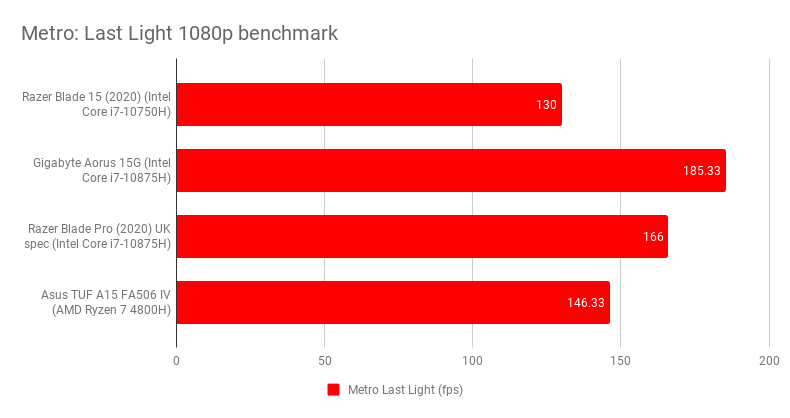
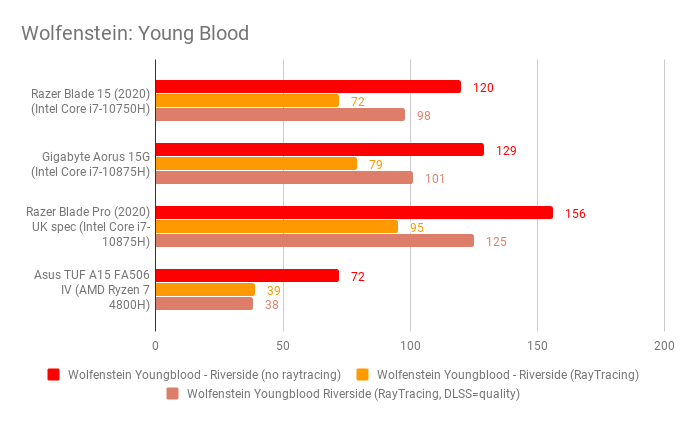

At extreme settings, the Hitman 2 benchmark returned a fairly sluggish result of 36fps but it only took knocking back super-sampling from 2 to 1 to bump that back up to a perfectly smooth 72fps. The fans stay pretty quiet most of the time, too, although you’ll be in no doubt when the CPU and GPU are working hard when the fans ramp up to maximum.
The Blade 15 (2020) has a quick SSD, too. It uses a 512GB Liteon NVMe M.2 SSD which is super fast for sequential reads although not quite so amazing for sequential writes, reaching speeds of 2,590MB/sec and 1,961MB/sec in AS SSD respectively.

Where the Razer Blade 15 (2020) suffers, particularly the Base model, is its battery life. Under the hood, the Blade has a comparatively small 65Wh battery and this compares poorly with its rivals. The Gigabyte Aorus 15G has a 45% bigger battery at 94Wh and the MacBook Pro 16in’s is 54% bigger at 99.8Wh. And, guess what? The Razer’s battery life is pretty poor as a result.
Indeed, in our comparatively low demand video rundown test, the Blade 15 lasted only 4hrs 29mins, which is worse than both of those rivals, by nearly three hours in the case of the MacBook Pro and two in the case of the Gigabyte.
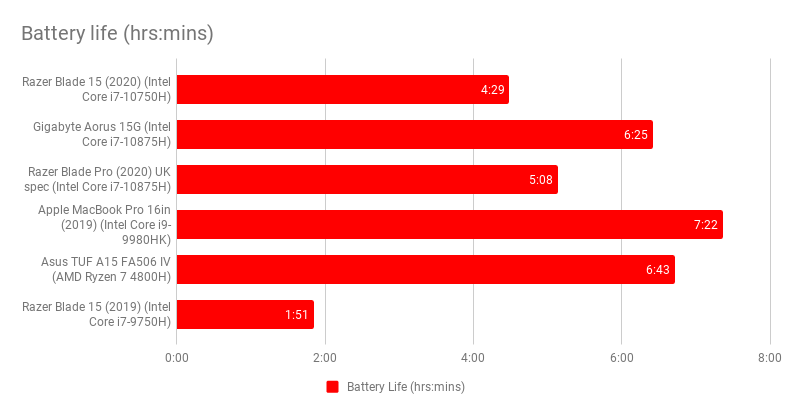
Whether or not this bothers you depends entirely on how much you see yourself using the machine when you’re out and about. If it’s mostly going to be plugged into the wall at home or in the office, then fine. But, make no mistake about it, this is far from the greatest laptop for working on the move; it might get you through half a day of work at the coffee shop before you have to go digging in your bag for the (fairly hefty) power adapter but little more than that.
Which one should you buy – Razer Blade 15 Base vs Razer Blade 15 Advanced 2020?
The base model and advanced model of the Razer Blade 15 differ in terms of specs, which I’ll dive into below. But they also have a few minor physical differences. For instance, the more affordable version lacks a UHS-III SD card reader, and neither its Thunderbolt 3 port nor its extra USB-C 3.2 Gen 2 port can be used to power the laptop. Both features are available in the advanced model. Spending more money means you generally get more features, though the advanced model does miss out on an Ethernet port.

Now, for some of the specs: The base Razer Blade 15 starts with a matte-textured FHD display with a 144Hz refresh rate, though you can upgrade to a more color-accurate OLED screen that has a 1ms response time. The advanced model ships with an LCD screen capable of a 300Hz refresh rate, and you can also upgrade this model to an OLED. However, only the OLED with the advanced option supports touch and is covered in Corning Gorilla Glass.
Both configurations ship with expandable M.2 2280 PCIe SSDs (256GB on the base model, 512GB on the advanced model, by default) and 16GB of DDR4 RAM clocked at 2,933MHz. Razer continues to use glass trackpads with Windows Precision drivers, so we can expect the same good performance there for tracking and using gestures.
Editor’s recommendations
- Huawei MateBook D 14 laptop 2020 review and RAM upgrade
- Surface Pro 3 vs iPad Pro drawing 2020 – is it worth buying?
- Microsoft Surface Book 3 vs Dell XPS 15 – are they good for gaming?
- How much is Apple 2018 13.3 in MacBook Air 13.3 price in USA?
- Asus Rog Zephyrus S ultra slim gaming laptop battery life
